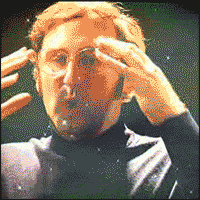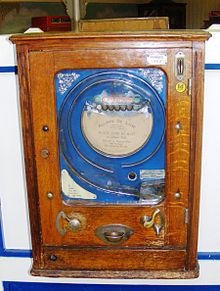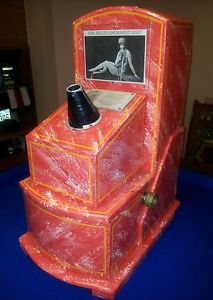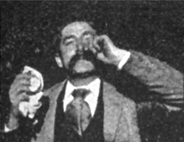So last time, we took a gander into the elegant beginnings of the mainstream media that swept across our nation, and we began to see a whole new hunger for the extraordinary and the fantastic. Though, thinking about it in that sort of mindset, you ask, “Well, where do we go from there?” And to answer that, we’d have to introduce something so amazing, so astounding that it had begun to send shockwaves on the way we saw entertainment, it was so astounding, so mind boggling that most were never read for it, and that is one thing we never saw coming…we would see the birth of…FILM
As said here “It been claimed that there is only one standard of measurement which is common to all nations of the earth. That measurement is the width of a piece of standard theatrical size motion picture film.”

But before we get to all that, let’s talk about how it began. As talked about earlier, one sort of entertainment that was pretty popular was that of the shadow puppet theaters. And it sort of grew from there, it turns out you can make all sorts of images from just clever blocking of the light, which is where we began to see the most primitive idea of film. One invention most widely know is that of the magic lantern.
This little device was used mostly for schools, but the idea is the same. You take a clear image with blacked out spots, you put it through the light and you see said image projected wherever you wish!
So back to film:
Film actually goes back as far as the early 1870s, and began by a man by the name of Eeadweard Muybridge, who was known for his practices with the idea of a series of images showing movement. In 1872 he came up with what was called a, Zoopraxiscope, a device which printed several images on one big film disk that was spun in from of a light to simulate movement. So, using several cameras that would be activated by a trip wire, he was able to capture the horse moving frame by frame with each snap of the photo. And transferring this to the Zoopraxiscope was able to show a horse in fast motion in actual movement. And now ladies and gentlemen, the first motion picture EVER.
Now, this may seem incredible anticlimactic, but what you have to realize is that this was the first time people could see actual movement from a still image that could be projected onto a screen! IT WAS A MOVING PICTURE, hence the title of motion picture. And this for people was honestly MINDBLOWING.
And due to the rising success of the Zoopraxiscope most audiences became generally fascinated upon the idea of viewing said images, and thus began the development of the ‘Theater Optique’. Which using what was called a Praxinoscope, a device which basically improved on the methods of the Zoopraxiscope, allowed the general public to view the motion pictures in a theater setting. Though these were again, limited to a point to where the real only things that worked were early ideas of what we had called cartoons. Though it did prove to be pretty popular.
It wasn’t until 1885 that two men, George Eastman and William H. Walker, had actually invented the first film strip. Which was sensitized paper coated with gelatin emulsion. Which basically meant this:
With the combination of chemicals the film strip was actually light sensitive, so when you put light through the paper it would burn onto the paper. With clever use of mirrors and several other devices it ultimately meant that an image could then be burned onto the sensitive paper. Which meant that you could capture several images in one film, that could either be projected or made bigger, and the idea of motion began in well the ye olde penny arcade.
What’s that? You’ve no idea what a penny arcade is? Well, granted, there are only some few and far between that currently exist, but back then, oh boy were they hot! A penny arcade is as the name implies, a venue full of machines that could be operated if you paid one penny. And this was anywhere from a simple slot machines!
Even a peep show!
And that’s the one I’m talking about, you put a penny in and you see a set of pictures that show a scene and story. The device, invented by thomas edison, was called the Kinetograph. As said here “It was a machine that could capture a sequence of images which was similar to a camera only it automatically took a picture of the moving image every half second. The images were then placed in his other invention, the kintescope. This device had a motor and shutter mechanism that ran a loop of film past an electric light source. The spectator would then peer through a small window to see the moving image.”
Though the film was then replaced by celluloid, which used the chemical compound cellulose nitrate. This was the first time that we now saw small scenes in motion, and it only exploded even more from there.
It was until two brothers Louis and Auguste Lumiere had invented the Cinematograph, a device which not only worked like edison’s Kinetegraph though it was able to actually project onto a large screen for audiences to view. And from then on, the film business had begun to boom.
Countries from all over the world had begun to invest into making motion pictures, though these were limited to one scene sets that had little to no movement involved and even some vaudeville acts could now be seen to entertain audiences worldwide.
It wasn’t until about 1910 where D. W. Griffith in some of his early short films, had begun to use such things as multiple camera angles, jump cuts, and from there the rest is pretty well known. What from silent film stars such as Charlie Chaplin, Buster Keaton, and Sarah Berndhart. And seeing such spectacles such as films such as The Phantom of the Opera
Metropolis,

Cinema was an established art that would take audiences by storm, though as the name of the era implies, these films were silent. The action was mostly that of the actors and the facial expressions they convey. Talking, if there was any, was usually shown in that of tile cards that would show whatever the actor was saying. Though it wasn’t until about 1920 that audiences were dazzled in one huge moment in The Jazz Singer hearing Jack Robin saying ‘You ain’t heard nothin yet’. It was then that a whole new era of film had begun.
So now, you may be wondering, ‘How in the world does this effect me?’ and to that I say, ‘YOU HAVE NO IDEA WHAT THIS MEANT’
Photography in it’s early stages were indeed a marvel as they became more and more available, they were able to capture a moment in time and have it available to the local customer for what they please. Though mind you, at first this was a sort of light and mirror burning image after a few minutes. So, with this not only did you have people creating an easier way of taking pictures, but you also had a new way of capturing many images on the same reel.
Not only did it become easier to capture more that one image, but you now had the means of showing moving images on one screen that could be recorded and reproduced and shown where ever you please. The film industry began to boom, and you now saw motion pictures at your local theater, they would even go from anywhere to newsreels, revues, big ticket films, and things that we often still see today. We would see in 1920 a new type of media that would make us laugh, cry, scream and be entertained. It was a whole new chapter in the mainstream media, and it would also give you a way to show more and more people different events and things that most wouldn’t have the chance to see. Things that would come from all over the world could now be seen everywhere. You would eventually start to see mass media cameras and ways of showing films, even to a point to where you had to figure out how to show it to a much wider audience. So the question came that, how do you introduce this to more and more people?
(Also, on the topic of movies, I highly recommend Sunset Boulevard, good noir about an aging silent film star, kinda fits in perfect with this topic.)
















